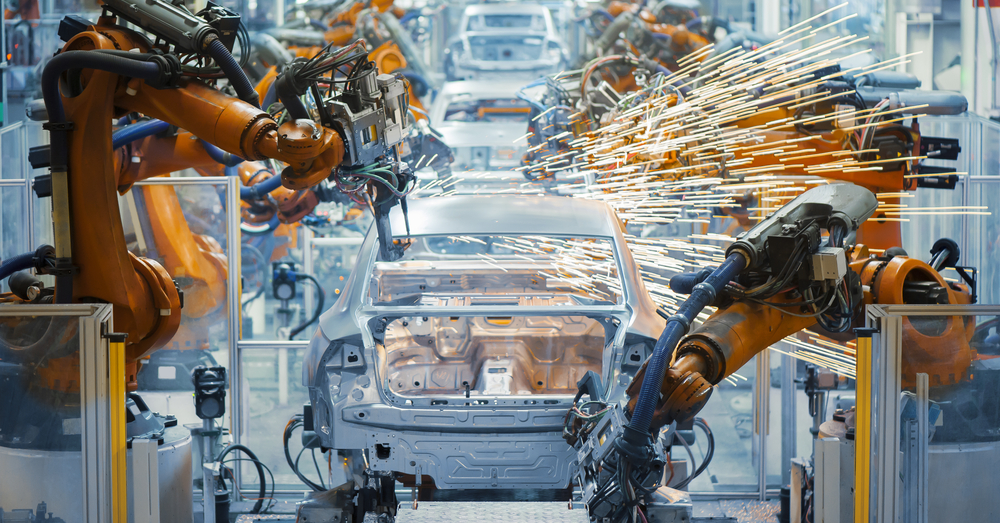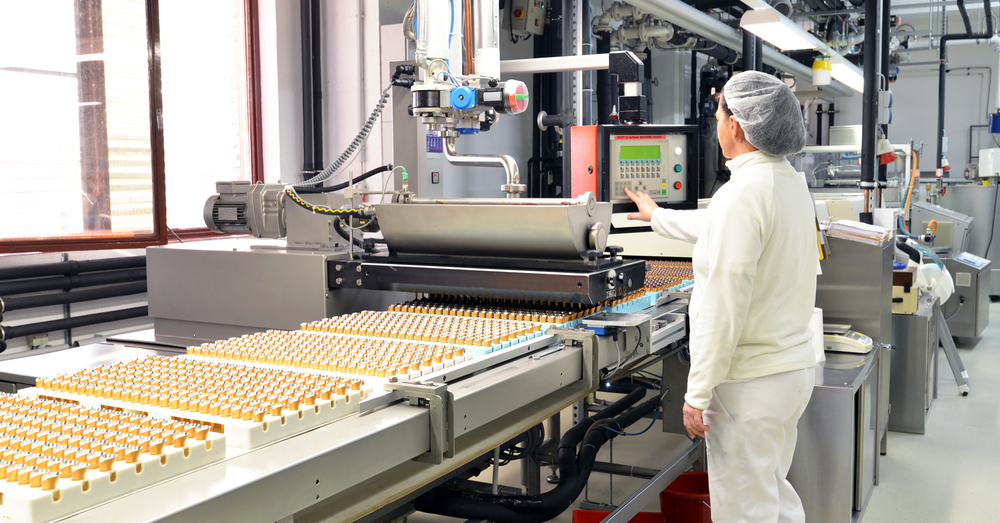Repetitive manufacturing and what crafters can learn from It
Stereotypically, when we think of the manufacturing industry, we imagine repetitive manufacturing. But what is it, and can growing manufacturers make use of it?
Team Katana

A full moon hangs above you in the cloudless night sky.
You tip-toe through a sterilized factory. Belts move, sparks fly, and machinery works away.
You notice you’re surrounded by large mechanical arms, picking away at the exoskeletons of cars.
They don’t stop. They don’t sleep. They don’t need food or water.
AAAAAAAAAAAAA!
This is repetitive manufacturing in action at an automobile production plant.
Not only is this the familiar sound of a horror film, but it’s also a way to describe a production method (we’ll explain how a little later).
You’ve just crossed over to the repetitive manufacturing process.
It might seem a daunting process for a business manufacturer, but it doesn’t hurt to know how the larger businesses operate.
We’ve also looked into the other types of manufacturing processes if you want to find a process which is more to your businesses speed.
So, we’re sorry if our introduction filled you with the heebie-jeebies. Hopefully, this video of a special type of conveyor belt will showcase the fun side of the repetitive manufacturing process.
Let’s dive in!
What is Repetitive Manufacturing?
Repetitive manufacturing is a manufacturing process which produces products for rapid production flow. A distinguishing characteristic of repetitive manufacturing is its use of assembly/production lines.
Manufacturers use this method when they are making products which are similar in design. Any variations in the product’s design will be marginal. Meaning this process isn’t suitable if you’re a maker, artist or crafter. A traditional, hands-on, method of manufacturing is more preferable. The products you make are more unique, customizable or their construction needs more attention to detail. Something which is difficult to achieve with this process.
Repetitive manufacturing adheres to a strict schedule to achieve a set production rate. Businesses set their production rates schedule by a daily, weekly or monthly target.
Because the production of the items is similar, this allows for a shorter set up time. As items are being perpetually made, the process shortens the manufacturing lead time.
Since you’re manufacturing products ahead of a customer’s order, the process needs a master production schedule to run efficiently.
Businesses that utilize repetitive manufacturing are ones who, for example, produce electronic goods, cars, and durable goods.
Another feature that is prevalent in repetitive manufacturing is the use of autonomous machinery.
Yes, the very machines that took a job from Charlie Bucket’s Dad at the beginning of Charlie and the Chocolate Factory (spoiler alert: he finds work as an engineer… at least in Tim Burton’s film adaptation he does!). Nevertheless, that’s how progress works, unfortunately.
Let’s look at an example of a business which uses repetitive manufacturing.
PRO TIP: Explore the frontier of the manufacturing industry and be ahead of the competition. We’ve crafted a ‘survival guide’ to help you get the lay of the land and understand what you need to thrive. Here we explain what is manufacturing from a scaling manufacturers perspective.
Repetitive Manufacturing Process Examples
Building PC cases.
Since nerds are (and always were) in vogue.
To manufacture a PC case, you will need to:
First Step – Design
Create blueprints and edit until agreed that’s how the final product should look.
Second Step – Raw Materials
The preparation of raw materials necessary for creating the PC case.
Third Step – Lazer Cutting and Pressing
With the factory’s computers calibrated, the machines will begin intricately cutting the material.
The process also makes use of pressing machines, to cut holes for various reasons, such as for ventilation.
Final Step – Washing, Grinding and Flattening
The case’s panels will each go through cleaning, polishing and flattening to prepare the final product.
If components (RAMs and Hard drives etc.) are also added by the same company, this will turn the production into a discrete manufacturing process.
The repetitive manufacturing process means products move uninterrupted from one step to the next to achieve maximum efficiency.
If you’re a visual learner, this video on manufacturing PC cases will be more beneficial for you.
But, if you’re still struggling to understand how to achieve repetitive manufacturing, here is the work-flow simplified:
Product = A
Repetitive Manufacturing = AAAAAAAAAAAAAAAAAAAAAAAAAA
As a modern manufacturer, it might be problematic to try and use this type of process.
This process is best for large scale manufacturers. Though customer attitudes toward this production method are changing.
Customers, particularly millennials, want to know the history of their products. They want a product that doesn’t come at the expense of the environment. They want items which cater to their individual needs. Keeping up with manufacturing trends and putting care into your products is what’s going to help you survive.
Though, there’s a reason businesses still use repetitive manufacturing. So, why not make yourself aware of the pros and cons, as it’ll help you with running your own business.

Employees working on a production line in a factory that uses a repetitive manufacturing system.
Advantages of Repetitive Manufacturing
1. Cost Efficient
The process reduces the cost to produce items.
2. Frees Resources
The continuous nature means time is only spent on manufacturing products. Also, employees’ responsibilities don’t often change. More than likely, they’ll be responsible for maintaining machinery.
3. Low Skill Level
The use of machinery for complicated tasks means the job could potentially have a low entry point for prospective employees.
4. Easier to schedule
The schedule follows the production rate.
5. Define production Speeds
Change the production rates speed to achieve the desired output.
6. Performance Visibility
A products manufacturing process can be easily monitored from one location, from start to finish.
Disadvantages of Repetitive Manufacturing
1. Tear Downs
If a different item or how the manufacturing of an item changes, the business needs to reassemble the production line. Doing so can be costly to the business.
2. Less Customization
Mass produced items mean customers have less chance to personalize their orders.
3. Low Skill Level
It’s a blessing and a curse. Work can be monotonous and boring, as the same thing will be repeated every day by employees who’re uninspired.
4. Customer Demand
Demand changes all the time, your production rate always runs the risk of not meeting or overestimating the demand for your product.
5. Difficult to Track Cost of Goods Sold (COGS)
The value of your products will fluctuate since they’re constantly in production. Many businesses use the not-so-kosher practice of backflushing. It’s a simple accounting system where you ignore the direct material and direct labor costs. Here, the products will have a standard cost.
What Can a Scaling Manufacturer Learn from Repetitive Manufacturing?
Being in competition against a giant corporation pumping out products via repetitive manufacturing seems scary.
But you don’t need to be an industrial powerhouse to manufacture your wares.
These large, faceless, entities produce items with little thought. Driving more and more customers to search for products that they can personalize.
With other businesses making use of eCommerce sites, they can avoid the traditional route of selling their products through a wholesaler. Meaning you can sell your products directly to your customers.
As some businesses transfer to repetitive manufacturing, they’re inadvertently diluting the skill level of workers. A skill gap which is only growing bigger as people continue to misunderstand the manufacturing industry.
If you want to be successful, concentrate on growing your business by using manufacturing ERP software.
This’ll be helpful as you transition from the increase in consumer demand. It’ll also conveniently help you track your business from one dashboard.
Team Katana
Table of contents
Get inventory trends, news, and tips every month
Get visibility over your sales and stock
Wave goodbye to uncertainty with Katana Cloud Inventory — AI-powered for total inventory control